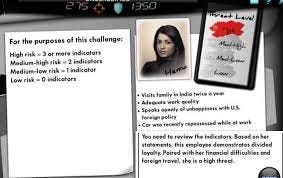Warning: Anyone that's unhappy with U.S. foreign policy might be a "high threat"

A security training test created by a Defense Department agency warns federal workers that they should consider the hypothetical Indian-American woman a "high threat" because she frequently visits family abroad, has money troubles and "speaks openly of unhappiness with U.S. foreign policy."
That slide, from the Defense Information Systems Agency (DISA), is a startling demonstration of the Obama administration's obsession with leakers and other "insider threats." One goal of its broader "Insider Threat" program is to stop the next Bradley Manning or Edward Snowden from spilling classified or sensitive information.
But critics have charged that the Insider Threat program, as McClatchy first reported, treats leakers acting in the public interest as traitors -- and may not even accomplish its goal of preventing classified leaks.
DISA's test, dubbed the "CyberAwareness Challenge," was produced in October 2012, a month before the Obama administration finalized its Insider Threat policy. The slide about Hema is included in a section of the training about "insider threats," which are defined by an accompanying guide as "threats from people who have access to the organization's information systems and may cause loss of physical inventory, data, and other security risks."
Both Hema's travel abroad and her political dissatisfaction are treated as threat "indicators." Versions of the training for Defense Department and other federal employees are unclassified and available for anyone to play online.
"Catch me if you can," the training dares.
In a statement to The Huffington Post, Pentagon spokesman Lt. Col. Damien Pickart said, "DISA was sensitive to any civil liberty concerns that might arise from any portion of the curriculum, which is why it coordinated with 26 federal agencies to ensure the maximum amount of input was received before going live."
"When considering personnel for a position of trust that requires a security clearance, there are many potential indicators that must be considered when evaluating for insider threat concerns," he explained. "The department takes these variables into consideration based on past examples of personnel who engaged in spying or treasonous acts."
Several million people across the federal government have taken the training since it was released, Pickart said, and there has been only one complaint. He added that the next version of the security awareness training, to be released in October, is being updated so that its insider-threat test focuses more on behavior, "not personal characteristics or beliefs."
Notably, the CyberAwareness Challenge is given to a wide range of federal employees whose roles have far less to do with security threats than that of a National Security Agency contractor like Snowden. The Department of Housing and Urban Development even requires its private business partners accessing a tenant rental assistance database to complete the training.
The "Hema" test is just an example of an increasingly paranoid attitude coming from the Obama administration concerning insider threats. It's premature and unwise to assume that American Gestapo will be cracking down the door tomorrow because you posted an Obama meme, but with the recent PRISM scandal and the institutionalization of paranoia profiling within this test, one can certainly worry about the overall attitude and political climate.
There's a reason for this test to be particularly worrisome. Whether you agree with it or not, there has been profiling since 9/11 for foreigners and ethnicities associated with terrorism. This is still present on the test. However, disliking U.S. foreign policy and having economic woes are commonplace among many if not most Americans.
Even the government’s top scientific advisers have questioned these techniques. Those experts say that trying to predict future acts through behavioral monitoring is unproven and could result in illegal ethnic and racial profiling and privacy violations.
Read more here: http://www.mcclatchydc.com/2013/07/09/196211/linchpin-for-obamas-plan-to-predict.html#storylink=cpy“There is no consensus in the relevant scientific community nor on the committee regarding whether any behavioral surveillance or physiological monitoring techniques are ready for use at all,” concluded a 2008 National Research Council report on detecting terrorists.
“Doing something similar about predicting future leakers seems even more speculative,” Stephen Fienberg, a professor of statistics and social science at Carnegie Mellon University in Pittsburgh and a member of the committee that wrote the report, told McClatchy.
Some government programs that have embraced behavioral indicators have been condemned as failures. Perhaps the most heavily criticized is the Transportation Security Administration’s Screening of Passengers by Observation Techniques, or SPOT, program.
The program, which has cost $878 million and employs 2,800 people, uses “behavior detection officers” to identify potential terrorists by scrutinizing airline passengers for signs of “stress, fear or deception.”
DHS’ inspector general excoriated the program, saying in a May 2013 report, “TSA cannot ensure that passengers at United States airports are screened objectively, show that the program is cost-effective or reasonably justify the program’s expansion."
http://www.huffingtonpost.com/2013/08/07/insider-threat-training_n_3714333.html
http://www.mcclatchydc.com/2013/07/09/196211/linchpin-for-obamas-plan-to-predict.html#.UgOWTZTD-Uk
http://www.policymic.com/articles/58561/disliking-u-s-foreign-policy-now-makes-you-a-high-threat


